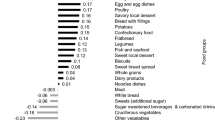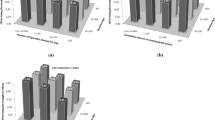Abstract
Heavy kava use has been associated with sudden death in Aboriginal Australians in Arnhem Land (Northern Territory, Australia) where poor diets and a high incidence of premature coronary heart disease are known. Heavy kava users may suffer additional risk if further malnourished. Among 98 people (62 males, 36 females) in one community, 36 never used kava, 26 were past users, and 36 were continuing users. Across kava-using groups skinfold thickness, body mass index and body fat decreased. Total- and LDL-cholesterol were elevated in kava users compared to both former users and never users. HDL-cholesterol was higher in current users vs never users. Across kava-using groups, triglycerides, homocysteine and diet-derived antioxidant vitamins α-tocopherol and retinol, did not vary. Plasma carotenoid levels (indicative of vegetable and fruit intake) were very low, but when adjusted for plasma cholesterol, did not vary between kava-using groups. An obsession for kava drinking may mediate kava's direct effects on nutritional status.
This is a preview of subscription content, access via your institution
Access options
Subscribe to this journal
Receive 12 print issues and online access
$259.00 per year
only $21.58 per issue
Buy this article
- Purchase on Springer Link
- Instant access to full article PDF
Prices may be subject to local taxes which are calculated during checkout
Similar content being viewed by others
References
Brunton R (1989): The Abandoned Narcotic: Kava and Cultural Instability in Melanesia. Cambridge: Cambridge University Press.
Cawte J (1985): Psychoactive substances of the south seas: betel, kava and pituri. Aust. NZ J. Psychiatr. 19, 83–87.
Clough AR, Burns CB & Mununggurr N (2000): Kava in Arnhem Land: a review of consumption and its social correlates. Drug Alcohol Rev. 19, 319–328.
Clough AR, Jacups SP, Wang Z, Burns CB, Bailie RS, McDonald SP, Cairney SJ, Guyula T & Currie BJ (2003): Health effects of kava use in an eastern Arnhem Land Aboriginal community. Int. Med. J. 33, 336–340.
Ford ES & Giles WH (2000): Serum vitamins, carotenoids, and angina pectoris: findings from the National Health and Nutrition Examination Survey III. Ann. Epidemiol. 10, 106–116.
Frater AS (1952): Medical aspects of yaqona. Trans. Proc. Fijian Soc. 5, 31–39.
Holmes L (1967): The function of kava in modern Samoan culture, In Ethnopharmacological Search for Psychoactive Drugs, ed. D Efron, publication no. 1645. Washington: US Public Health Service.
Ito Y, Ochiai J, Sasaki R, Suzuki S, Kusuhara Y, Morimitsu Y, Otani M & Aoki K (1990): Serum concentrations of carotenoids, retinol, and alpha-tocopherol in healthy persons determined by high-performance liquid chromatography. Clin. Chim. Acta 194, 131–144.
Lebot V, Merlin M & Lindstrom L (1997): Kava, The Pacific Elixir: the Definitive Guide to its Ethnobotany, History and Chemistry, 2nd Edition. Rochester, Vermont: Healing Arts Press.
Lee AJ, Bonson APV & Yarmirr D (1995): Sustainability of a successful health and nutrition program in a remote Aboriginal community. Med. J. Aust. 162, 632–635.
Mathews J, Riley M, Fejo L, Munoz E, Milns NR, Gardner ID, Powers JR, Ganygulpa E & Gununuwawuy BJ (1988): Effects of the heavy usage of kava on physical health: summary of a pilot survey in an Aboriginal community. Med. J. Aust. 148, 548–555.
Naschitz JE, Slobodin G, Lewis RJ, Zuckerman E & Yeshurun D (2000): Heart diseases affecting the liver and liver diseases affecting the heart. Am. Heart. J. 140, 111–120.
Norton SA & Ruze P (1994): Kava dermopathy. J. Am. Acad. Dermatol. 31, 89–97.
Rowley KG, Su Q, Concotta M, Skinner M, Skinner K, Pindan B, White GA & O'Dea K (2001): Improvements in circulating cholesterol, antioxidants, and homocysteine after dietary intervention in an Australian Aboriginal community. Am. J. Clin. Nutr. 74, 442–448.
Ruze P (1990): Kava-induced dermopathy: a niacin deficiency? Lancet 335, 1442–1445.
Singh Y (1992): Kava: an overview. J. Ethnopharmacol. 37, 13–45.
Stone NJ (1994): Secondary causes of hyperlipidemia. Med. Clin. North. Am. 78, 117–141.
Thomson NJ (1991): Recent trends in Aboriginal mortality. Med. J. Aust. 154, 235–239.
Wang Z, Hoy W & McDonald S (2001): Body mass index in Aboriginal Australians in remote communities. Aust. NZ J. Public Health 24, 570–575.
Young M, Fricker P, Thomson N & Lee K (1999): Sudden death due to ischaemic heart disease in young Aboriginal sportsmen in the Northern Territory, 1982–1986. Med. J. Aust. 170, 425–428.
Acknowledgements
We are grateful to Dr Qing Su and her laboratory staff for carrying out the carotenoid assays. Carotenoid assays were funded by National Health and Medical Research Council, Australia (NHMRC) Grant #981010 and the lipid levels and physical assessments from NHMRC Grant #980434. We thank Dr Chris Burns and Prof Bart Currie for project development and Ms Kath Flyn for data collection and compilation, Mr Terrence Guyula, Roslyn Wunungmurra and Susan Ninikirri for assistance with the research. We declare that the paper's publication creates no conflict of interest. Dr Rowley is a VicHealth Public Health Research Fellow.
Author information
Authors and Affiliations
Corresponding author
Rights and permissions
About this article
Cite this article
Clough, A., Rowley, K. & O'Dea, K. Kava use, dyslipidaemia and biomarkers of dietary quality in Aboriginal people in Arnhem Land in the Northern Territory (NT), Australia. Eur J Clin Nutr 58, 1090–1093 (2004). https://doi.org/10.1038/sj.ejcn.1601921
Received:
Revised:
Accepted:
Published:
Issue Date:
DOI: https://doi.org/10.1038/sj.ejcn.1601921



